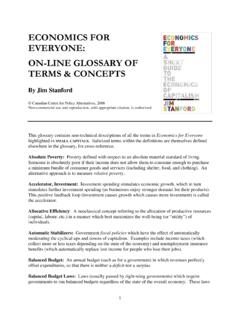Transcription of ECONOMICS FOR EVERYONE: ON-LINE GLOSSARY OF TERMS …
1 1 ECONOMICS FOR EVERYONE: ON-LINE GLOSSARY OF TERMS & CONCEPTS By Jim Stanford Canadian Centre for Policy Alternatives, 2008 Non-commercial use and reproduction, with appropriate citation, is authorized. This GLOSSARY contains non-technical descriptions of all the TERMS in ECONOMICS for Everyone highlighted in SMALL CAPITALS. Italicized TERMS within the definitions are themselves defined elsewhere in the GLOSSARY , for cross-reference. Absolute Poverty: Poverty defined with respect to an absolute material standard of living.
2 Someone is absolutely poor if their income does not allow them to consume enough to purchase a minimum bundle of consumer goods and services (including shelter, food, and clothing). An alternative approach is to measure relative poverty. Accelerator, Investment: Investment spending stimulates economic growth, which in turn stimulates further investment spending (as businesses enjoy stronger demand for their products). This positive feedback loop (investment causes growth which causes more investment) is called the accelerator.
3 Allocative Efficiency: A neoclassical concept referring to the allocation of productive resources (capital, labour, etc.) in a manner which best maximizes the well-being (or utility ) of individuals. Automatic Stabilizers: Government fiscal policies which have the effect of automatically moderating the cyclical ups and downs of capitalism. Examples include income taxes (which collect more or less taxes depending on the state of the economy) and unemployment insurance benefits (which automatically replace lost income for people who lose their jobs).
4 balanced Budget: An annual budget (such as for a government) in which revenues perfectly offset expenditures, so that there is neither a deficit nor a surplus. balanced Budget Laws: Laws (usually passed by right-wing governments) which require governments to run balanced budgets regardless of the state of the overall economy. These laws 2have the negative effect of worsening economic downturns since governments either must reduce spending or increase taxes during a recession, in order to offset the impact of the recession on its budget, and those fiscal actions deepen the recession.
5 3 Bank for International Settlements: An international financial regulatory organization based in Berne, Switzerland, which designs international regulations regarding capital adequacy and other banking practices. The BIS is governed by government appointees from the world s largest capitalist economies. Banking Cycle: An economic cycle which results from cyclical changes in the attitudes of banks toward lending risk. When economic times are good, bankers become optimistic that their loans will be repaid, and hence they expand their lending.
6 More credit means even stronger economic times, and so on. The opposite occurs when the economy becomes weaker: bankers begin to fear more defaults on their loans, hence they issue fewer loans, and hence the economy weakens even further. Banks: A company that accepts deposits and issues new loans. It makes profit by charging more interest for the loans than it pays on the deposits, as well as through various service charges. By issuing new loans (or credit), banks create new money which is essential to promoting economic growth and job creation.
7 Barter: A form of trade in which one good or service is exchanged directly for another, without the use of money as an intermediary. Bond: A financial security which represents the promise of its issuer (usually a company or a government) to repay a loan over a specified time period, at a specified rate of interest. The bond can then be bought and sold to other investors, over and over again. When the rate of interest falls, bond prices rise (and vice versa) since when interest rates are lower, the bond s promise to repay interest at the specified fixed rate becomes more valuable.
8 Capacity Utilization: A company or economy s capacity represents the maximum amount of output it can produce. The rate of capacity utilization, therefore, represents the proportion of capacity that is actually used in production. When capacity utilization is high (so that a facility is being used fully or near-fully), pressure grows for new investment to expand that capacity. Also, high capacity utilization tends to reduce the unit cost of production (since capital assets are being used more fully and efficiently). Capital: Broadly defined, capital represents the tools which people use when they work, in order to make their work more productive and efficient.
9 Under capitalism, capital can also refer to a sum of money invested in a business in hopes of generating profit. (See also: circulating capital, fixed capital, human capital, machinery and equipment, physical capital, and structures.) Capital Adequacy: Capital adequacy rules are loose regulations imposed on private banks, in hope of ensuring that they have sufficient internal resources (including the money invested by the bank s own shareholders) to be able to withstand fluctuations in lending and profitability. 4 Capital Flight: A destructive process in which investors (both foreigners and domestic residents) withdraw their financial capital from a country as a result of what are perceived to be non-favourable changes in economic policies, political conditions, or other factors.
10 The consequences of capital flight can include a contraction in real investment spending, a dramatic depreciation in the exchange rate, and a rapid tightening of credit conditions. Developing countries are most vulnerable to capital flight. Capital Gain: A capital gain is a form of profit earned on an investment by re-selling an asset for more than it cost to buy. Assets which may be purchased for this purpose include stocks, bonds, and other financial assets; real estate; commodities; or fine art. Capitalism: An economic system in which privately-owned companies and businesses undertake most economic activity (with the goal of generating private profit), and most work is performed by employed workers who are paid wages or salaries.



